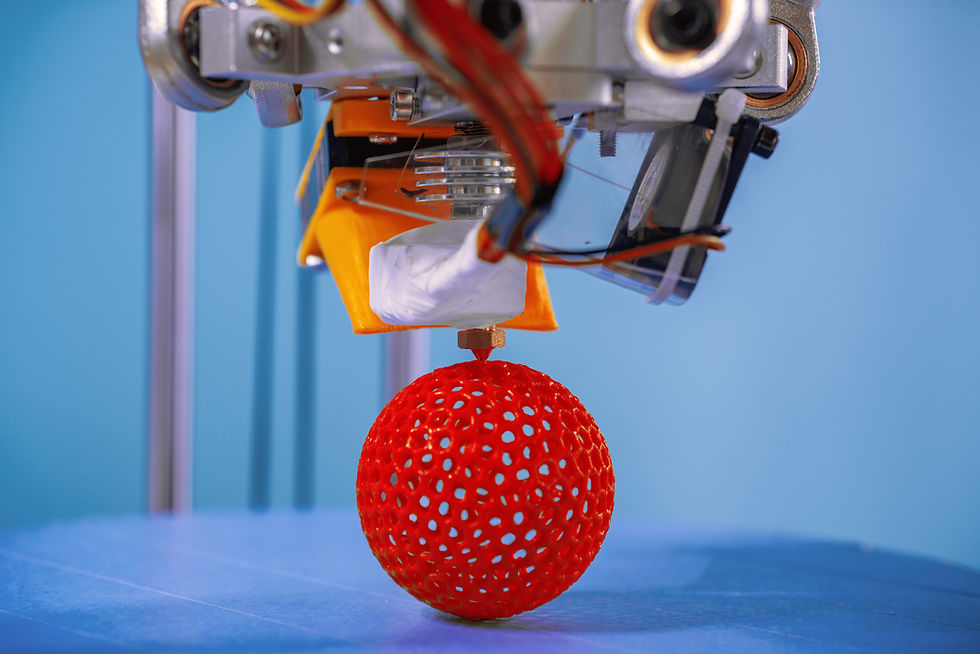Completing Your First Print! Part 5!
- Sejal Bilwar

- Aug 3, 2022
- 3 min read
Written By: Anna Lucas

So, you have finally chosen your printer, chosen your software, designed your first print, assembled your printer, made all the necessary upgrades and personalizations, and are ready to complete your very first print. Congratulations! This is a huge step forward in your engineering journey and education, and you are about to be introduced into a whole new realm of possibilities! So, let’s get started with a step-by-step guide into how to complete your first print!
The first thing you must do before you begin printing is to thread in your filament. On every 3D printer, there will be a small hole at the very top of your extruder. To the right of this hole, there should also be two black levers of sorts. In order to thread in your filament, you need to pinch these two levers and use a good amount of strength to attempt to pull them together as much as possible. The closer the levers are to each other, the easier it will be to thread in your filament, but be careful not to break them as they are a pain to replace. After pinching these levers, begin to thread your filament into this hole, and then into the second whole directly behind the first one which should lead into your extruder. It is quite difficult to thread the filament into the second hole, so try not to get frustrated when it takes several tries to accomplish. Once you have the filament threaded through both holes, begin to gently push the filament down into the tubing until you hit a block. Once you feel this block and can no longer push the filament any further, stop and hang your filament’s spool on the above knob.
Then, before you even turn on your printer to begin your first print, you need to level your printer bed first. To level your printer bed is to complete the process of completely flattening your printer’s bed to be the exact amount of millimeters away from your extruder in order for the filament to be close enough to the extruder for the filament to easily and precisely law on the bed where it was placed, while also being far enough from the extruder that the extruder doesn’t scratch on the surface of the bed. This may seem very complicated, but it really isn’t. The best way to complete this leveling is to get a regular piece of printer paper, and place it on your bed. Then, move your extruder all the way down your printer until it rests on your bed. Then, look underneath your printer’s bed, and you should find four gears that can turn either left or right. By turning the gears left, you will move the bed up, and by moving the gears right you will lower the bed. You should continue to move each of the four gears from left to right until the extruder lightly drags on the paper when moving it from corner to corner, enough to cause friction, but not enough to rip the paper. Once your bed is leveled, be careful not to touch it as every move, bump, touch, or tap could cause it to become un-leveled and force you to repeat the entire leveling process again.
After your bed is leveled, it is time to begin heating your bed. To do this, as mentioned before, it is best to look up online the optimum temperatures for both the extruder and the bed for your specific type of filament, as these temperatures will vary depending on the type of filament you will use. Once you know these temperatures, go into your printer’s heat settings and input your chosen temperatures, then standby as it begins to heat up. As your printer is heating up, insert a micro-sim card into your computer, and load the 3D print file that you are using for this print onto the sim card. Then, remove the sim card from your computer, and insert it into the base of your printer where there is a slot for the sim card. After this is completed, simply go into your printer's settings, choose your file, and begin your print! Make sure to keep a close eye on it to make sure that the extruder is working correctly, and that your print isn’t failing. Once your print is finished, simply switch off your 3D printer, allow your print a short amount of time to cool down, and carefully peel your print off of the bed.







Comments